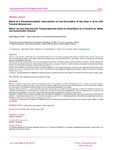Efecto de una intervención fisioterapéutica sobre la cinemática de la rodilla en niñas con anteversión femoral

Ver/Abrir
Use este enlace para citar
http://hdl.handle.net/2183/30225
Excepto si se señala otra cosa, la licencia del ítem se describe como Atribución-NoComercial-CompartirIgual 4.0 Internacional (CC BY-NC-SA 4.0)
Colecciones
Metadatos
Mostrar el registro completo del ítemTítulo
Efecto de una intervención fisioterapéutica sobre la cinemática de la rodilla en niñas con anteversión femoralTítulo(s) alternativo(s)
Effect of a Physiotherapeutic Intervention on the Kinematics of the Knee in Girls With Femoral AnteversionFecha
2020-12-26Cita bibliográfica
Miguel Andrés, I., López Ortíz, A., & Arrayales Millán, E. M. (2020). Efecto de una intervención fisioterapéutica sobre la cinemática de la rodilla en niñas con anteversión femoral. European Journal of Podiatry / Revista Europea de Podología, 6(2), 50-57. https://doi.org/10.17979/ejpod.2020.6.2.6417
Resumen
[Resumen] Objetivos: El objetivo del presente estudio fue determinar el efecto de un programa de acondicionamiento físico de 12 semanas, sobre la patología de anteversión femoral en niñas de seis años, a través de la medición de los rangos de movimiento de las rodillas durante el ciclo de marcha, antes y después de la intervensión. Siete niñas de seis años de edad con anteversión femoral participaron en el estudio. Material y Métodos: Primero, se evaluó la marcha de las niñas con la ayuda de un sistema de cámaras infrarrojas y marcadores reflejantes. Posterior a la evaluación de la marcha de los participantes, se continuo con el proceso de intervención fisioterapéutica. Una vez transcurridas las 12 semanas de la intervención fisioterapéutica, se procedió a evaluar nuevamente la marcha para determinar el efecto de la intervención. Resultados: El análisis t-test de muestras pareadas mostró una diferencia significativa en la disminución del rango de movimiento de la rodilla derecha posterior a la intervención, entre el 50% y 81% del ciclo de marcha (p-value<0.05). La rodilla izquierda mostró una diferencia significativa posterior al tratamiento, entre el 50% y 76% del ciclo de marcha (p-value<0.05). Conclusiones: El tratamiento fisioterapéutico de rehabilitación generó una disminución significativa del rango de movimiento de ambas rodillas en la etapa de oscilación. [Abstract] Objectives: The objective of this study was to determine the effect of a 12-week fitness program on the pathology of femoral anteversion in six-year-old girls, by measuring the ranges of movement of the knees during the gait cycle before and after the intervention. Seven six-year-old girls with femoral anteversion participated in the study. Material and Methods: First, the gait of the girls was evaluated with the help of an infrared camera system and reflective markers. After the evaluation of the gait in the participants, the process of physiotherapeutic intervention was started. After the 12 weeks of the physiotherapeutic intervention had elapsed, the gait was re-evaluated to determine the effect of the intervention. Results: Paired sampled t-test analysis showed a significant difference in the decrease in the range of motion of the right knee after the intervention, between 50% and 81% of the gait cycle (p-value <0.05). The left knee showed a significant difference after treatment, between 50% and 76% of the gait cycle (p-value <0.05). Conclusion: the physiotherapeutic rehabilitation treatment generated a significant decrease in the range of movement of both knees in the oscillation stage.
Palabras clave
Marcha
Anteversión femoral
Rodilla
Terapia física
Gait
Femoral anteversion
Knee
Physical therapy
Anteversión femoral
Rodilla
Terapia física
Gait
Femoral anteversion
Knee
Physical therapy
Versión del editor
Derechos
Atribución-NoComercial-CompartirIgual 4.0 Internacional (CC BY-NC-SA 4.0)
ISSN
2445-1835






